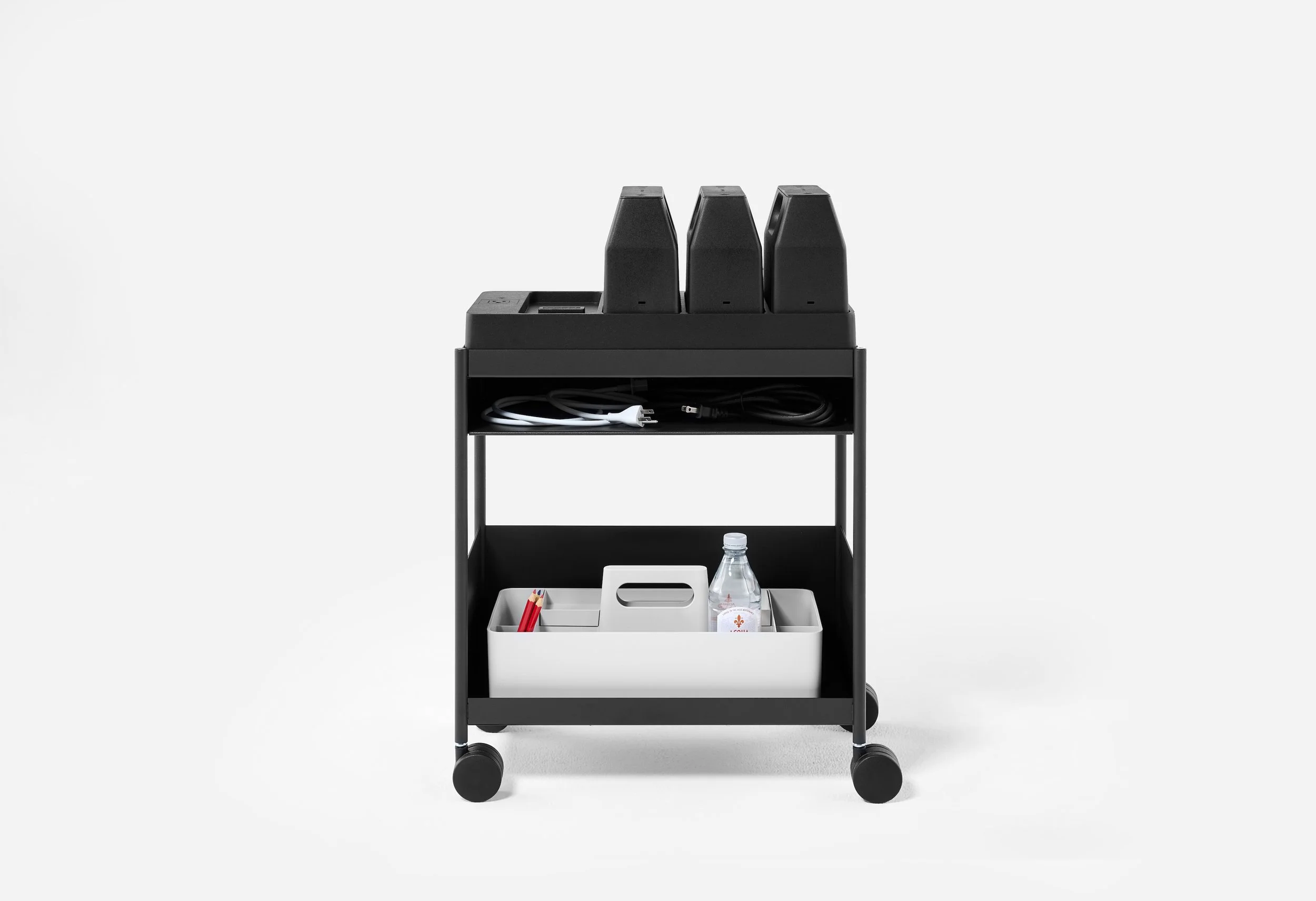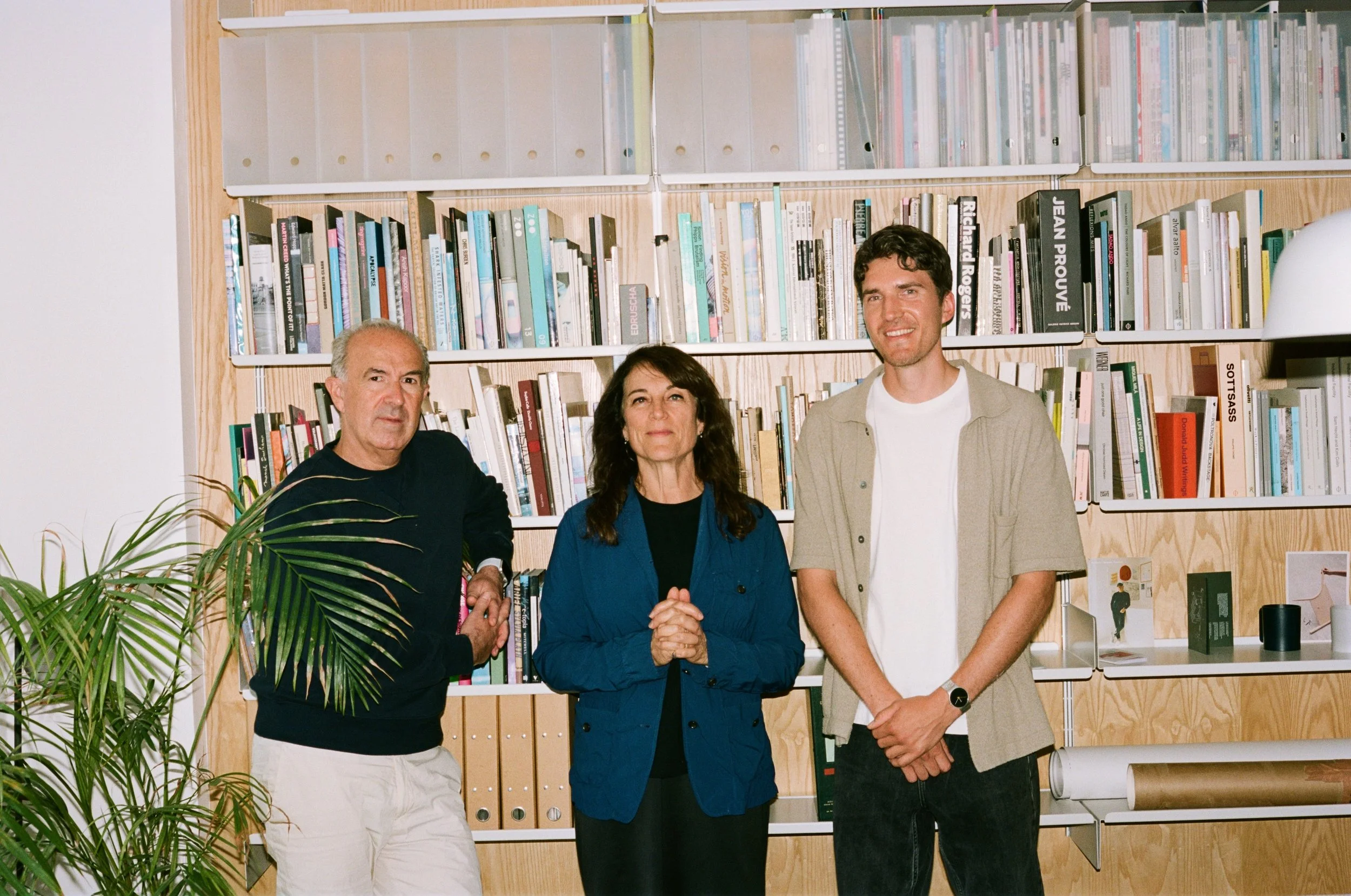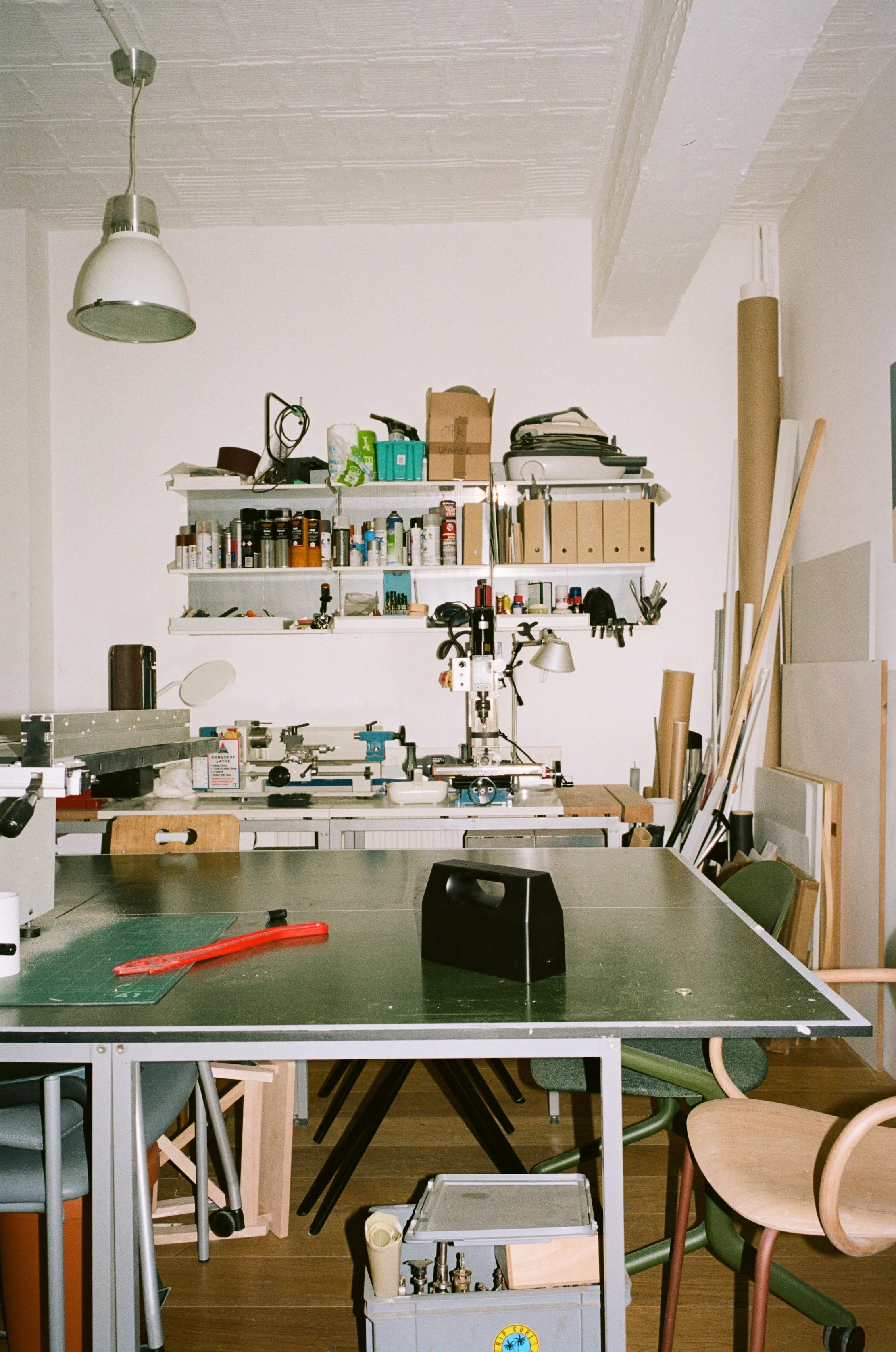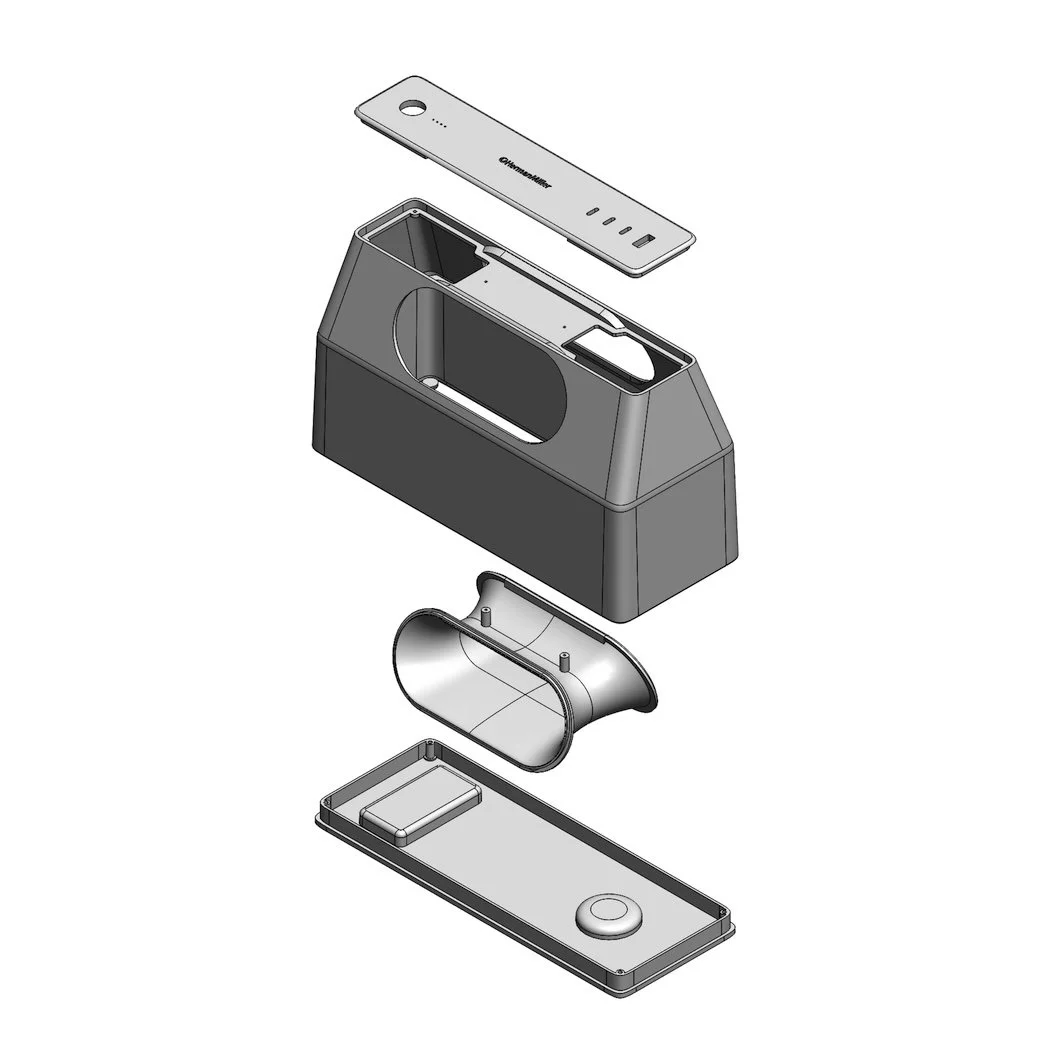Give Us This Day Our Daily Watts
The Powerbox battery, designed by Industrial Facility for Herman Miller, was created to enable nomadic working (image: Kane Hulse).
“She started up just fine this morning. This afternoon... clunk.”
That’s 1967 ad copy, by the way, in case the pronoun didn’t give it away. It’s the first sentence of a thick block of marketing text about lead-acid car batteries, printed beneath a black and white aerial shot of an American football stadium. A game has let out earlier in the day and the stadium is long since silent. “If only you’d known,” the advert continues. “A dying battery can tell you when it’s about to give up the ghost, but you have to pay attention.” Just visible alongside the stadium’s long, late-afternoon shadow, a single car remains stationary in the car park. “Now,” the headline asks, “don’t you wish you had the DieHard?”
Prior to researching this essay, I didn’t know that DieHard was a brand of batteries, which is a gap in my knowledge I’m happy to have addressed. Personally, I think that “DieHard” is an excellent name for a battery, primarily because it makes me think of Alan Rickman doing a German accent. But even if DieHard doesn’t have that association for you, it’s still a good name. When the batteries launched in 1967, for example, advertising agency J. Walter Thompson ran a consumer survey and results were favourable. People liked “DieHard’s” connotations of durability and longevity, even if they weren’t too fussed about the specifics. “I can’t say too much about the battery in my car,” one respondent explained. “Mostly, I take it for granted.”
A Powerbox in Industrial Facility’s studio (image: Kane Hulse).
Well, I can’t blame them, because taking energy for granted is one of the predominant social attitudes of the 20th and 21st centuries, at least in the Global North. “As the availability and reliability of energy improved, attention to it diminished,” writes historian James Morton Turner in his 2022 book Charged: A History of Batteries and Lessons for a Clean Energy Future. In many countries, we’re lucky enough to not have to think about our energy supply on a day-to-day basis because it’s just sort of there – electricity comes out the wall, yo! “This is one of the defining qualities of modernity,” Turner notes, “the intensification and the abstraction of energy consumption.” In 2021, for example, the world is supposed to have produced a grand total of 14,800 MToe of energy, but I must confess that I don’t know what a MToe is, let alone how you’d make one. Cut it off a MFt?
Within this sea of abstraction, batteries introduce another level of distance. Writing in the preface to Charged, historian Paul S. Sutter explains how batteries “provide energy that is cordless, reliable and portable”, serving as our best reserve of storable electricity and powering much of the tech that we surround ourselves with. But batteries are also a reserve whose physical form frequently feels divorced from the actual production of energy. Contemporary batteries are designed around convenience, taking shape as mute canisters, flat packets and sealed containers that are squirrelled away inside products – physically, they are what Sutter terms “a persistent black box that we take for granted without understanding their inner workings”. Looking at one, you’re unlikely to think about cathodes and anodes, or the electrolyte that enables their energising flow of electrons (unless you really like batteries). Which wouldn’t necessarily be a problem, except for the fact that we now live in a time when using “[energy] sustainably and efficiently”, in the words of Mateo Kries, director of the Vitra Design Museum, “is crucial for our future on planet Earth”.[1]
The Powertray and Powerboxes (image: Industrial Facility).
Across the board, societies are increasingly aware of the need to reduce energy consumption, yet the sheer convenience of contemporary batteries makes it easy to forget this on a personal level. They’re a portable archive of chemical energy, but one whose form betrays no sense of the physical processes generating said energy. After all, energy released anywhere is a trace of a physical event: of coal burning, atoms splitting, turbines turning. Batteries are charged with the energy released by these processes or else, in the case of non-rechargeables, release the energy inherent to their own material assembly and makeup. Hence why I mostly take them for granted. It’s all hidden away inside! I’m typing this essay on my laptop, for instance, and I haven’t given a moment’s thought to its internal battery: it’s keeping my laptop in power; it’s keeping me in prose. That’s as far as our relationship goes.
Growing up, I might have been able to tell you more. Ahead of long, trans-European car trips with my family, I would calculate the exact number of AA batteries needed to power my Game Boy Color for the full duration of the journey. This was vital, because I loved my Game Boy Color as if it were family, and I didn’t love my actual family enough to want to speak to them for even a single minute. I packed power carefully, stocking my backpack in perfect correlation with my consumption. “While disposable batteries have always delivered a vanishingly small amount of electricity,” Turner writes, “they have played a pivotal, but little-appreciated, role in enabling a modern culture of mobility.” At 10 years old, I could not have agreed more.[2] I measured out my life in AA batteries, even if the individual batteries themselves were of little consequence. Duracell, Energizer, Panasonic – whatever. To me, they were all just parcelled-up portions of game time: chemical permission to Mario.
Sam Hecht, Kim Colin and Leo Leitner (image: Kane Hulse).
Some 25 years on, I rarely use disposable batteries; my current roster of devices all have rechargeable lithium-ion ones instead. Today, I measure out my life in battery, singular: when a device flatlines, I plug it in – which is a considerable development in the history of product design. “Batteries are now sealed into products,” designer Leo Leitner tells me, moving around the desks and shelves of a third-floor studio space in Clerkenwell, London, busy seeking out packing materials. Leitner is the creative director of Future Facility, the technology-focused research wing of design studio Industrial Facility, which was founded by Sam Hecht and Kim Colin back in 2002.[3] It’s kind of Leitner to meet me: he’s struggling with a summer cold, but Hecht and Colin are out of the country with work, so he’s volunteered to come in to lend me a design they’ve been working on. “A product’s lifespan is now often determined by the lifespan of its battery,” he continues, taping up a cardboard box he’s picked out, “but tying a battery to a product, and determining the lifetime of products based off a battery is really, really bad.” He passes me the sealed box. “This, in a weird way, takes the two apart again.”
Ahead of meeting Leitner, I had let my laptop battery drain to zero, because if we were going to separate batteries and the products they power, I wanted to do things properly. Which is why I’ve also come to Waterlow Park in north London – no charge points in sight. It’s already bright and sticky-hot, with afternoon sunbathers brown and sweat-glossed, and tennis balls clocking back and forth across baked clay courts. But some of us have work to do, so Waterlow is going to be my office for the day. I start peeling the tape off the box, because if batteries enable a modern culture of mobility, then I’ve mobilised myself to have a lovely day in the park. In that vein, I’m now typing live from courtside, which is a luxury afforded by the black plastic device sitting next to me on the grass.
Image: Kane Hulse.
“OK, so let’s set the scene,” Hecht told me a week or so previously, when he, Colin and Leitner had first invited me to their studio. “What is Powerbox?” Most straightforwardly, Powerbox is a portable battery that provides sufficient energy to cover a day’s work for a single person, but that’s probably the boring answer. Instead, Industrial Facility tell me, you could frame Powerbox as being a solution to a problem surrounding power infrastructure. “Nomadic technology has allowed for nomadic work,” Colin explains, “which is the most important thing to solve [for design].” While many people can now work from anywhere, she continues, they’re constrained by the availability of power to enable that. This, she adds, is a concern for Herman Miller, the venerable US furniture design company, and a long-term collaborator of Industrial Facility. “The promise of agility is that I can work anywhere,” Hecht continues. “If I’ve got wireless wifi, then I’ll need wireless power, and for the last 10 years, we’ve been talking about that with Herman Miller. The constant answer we both gave is, ‘Well, eventually [the tech companies] are going to sort it out.’”
The problem, Hecht argues, is that said companies have not sorted it out: nomadic work remains dependent upon traditional power infrastructure, which is often limited, and various proposed fixes that have been considered to resolve this issue have not been properly thought through. Designing power-points into furniture, for instance, is a nonstarter, Colin explains, given that “technology changes way more than a chair needs to change, so the two cycles aren’t compatible,” while hardwiring additional infrastructure within a space is expensive and permanent, flying in the face of the flexibility that contemporary work professes to value. “Infrastructure is set,” Leitner notes, “whereas usage of a space evolves over time.” With this in mind, the team opted to explore batteries. “Herman Miller took the decision that because nobody else is doing this holistically,” Hecht explains, “then, well, screw it: we’ll just do it ourselves.”
A Henry Hoover being powered by Powerbox (image: Kane Hulse).
My loaned Powerbox is starting to attract glances from fellow park users, which probably isn’t surprising. After all, I’m carrying a laptop wired up to what looks like a car battery, albeit one that has been stripped of the garish brand labels normally plastered across them. The Powerbox has been designed to play upon memories of more familiar, bulky battery packs from the past – an all-black form that is recognisable to many, but anonymous in its detailing. Its main body is roughly the size and shape of a house brick, with its plastic curving up and around to form a thick handle embedded with multiple USB-C slots. There’s capacity to charge laptops, phones, tablets and pretty much anything else you might need, as well as a chunky On button to start the power flowing. That’s more or less it: it looks like a battery and it performs like one too, which is, of course, the point. “If we’re looking at something new, it needs to have some connection to our behaviour with that thing, our memory of that thing,” Colin tells me. “Recognisability ties into public memory,” Leitner adds. “What does an object do when I’ve never used it before? In the case of Powerbox, we tried to solve this through its form, which is making it recognisable as a battery.” But people are still staring at me because I’m sitting with a car battery peering at the tennis courts. It seems, somehow… unsavoury?
Part of the oddity of the situation may be that we’re no longer used to personal power infrastructure being anything other than discreet. “Batteries are relatively unique in their portability, storability, and ability to supply nearly instantaneous electricity on demand,” Turner writes, adding that they have in turn powered digital technologies that seem “ethereal, transcending the bounds of the physical world”. To enable this dematerialisation, the batteries themselves have needed to be intensely physical, however, having been forged throughout their history from ever more complex combinations of lead, sulphuric acid, mercury, manganese, zinc, steel, carbon, graphite, ammonium chloride, potassium hydroxide, cadmium, lithium, nickel or cobalt – they are, in this respect, what Sutter terms “of the earth[…] the stuff of mines and metallurgy and energy-intensive materials processing”. Batteries may be unobtrusive, but they’re also complex archives of elements carved out from rock and earth. “[Resource] omnivory has become characteristic of technological advance,” writes Turner. “The lowly beer can was once made of steel; now it is fabricated from three different aluminium alloys, each optimized for the body, top, or tab. A microprocessor relied on twelve elements in the 1980s; its elemental diversity exploded to more than sixty elements by the 2010s. Since 2000, the simple incandescent lightbulb has been replaced by far more efficient, but materially complex, LED bulbs. The pattern holds in the case of batteries, too.”
The different components of Powerbox (image: Industrial Facility).
You don’t normally think about this when a battery is sealed into a product because it’s just there, offering power on tap. With the Powerbox, however, it’s harder to get away from material realities. Industrial Facility’s design is offering me energy, but also feels physically substantial because the power it provides has a visible representation. It’s not as if everyone in Waterlow Park is suddenly aware of all the lithium and iron phosphate I’m packing, but it’s nevertheless unusual to be presented with a pleasingly chonky reminder of batteries’ physical existence, particularly when you’re trying to work on your backhand.
Admittedly, I’ve probably stretched Powerbox’s intended usage by coming here. The battery may be portable, but it’s still designed to be used within more traditional office spaces. It’s not a consumer product, Hecht notes, and its design “is not playing to consumer ideals”. While the battery is designed to provide what Hecht terms “personal power”, it’s also there to offer two additional things: “spatial power” and “facility visualisation”. The first of these is pretty straightforward: as opposed to going to the trouble of wiring a space, a company could electrify it by providing Powerboxes instead. “You could theoretically take over a warehouse with no power in it,” Hecht tells me. “You’re suddenly free from infrastructure, because you don’t actually need it.” All you need instead, he explains, is a single plug to charge the battery overnight or else to power the Powerbox’s docking station – dubbed a Powertray – which can charge up to four batteries at once.[4] This, the team explains, is why the design of the battery is purposefully industrial. “We want this to not feel natural for you to carry home,” Leitner tells me, “because it’s not your device.” And yet, here I am. In the park. With my Powerbox.[5]
“The production of electricity is physically substantive, and I like a battery whose presence reminds me of this, because perhaps power is something that should not be hidden away.”
If that’s “spatial power”, then “facility visualisation” is a little more fiddly to explain. “Power is not really something visual,” Hecht tells me. “You can’t really see what people are using individually [or in different areas of a space], so I don’t know if our workshop, for example, is using a lot of power or not much.” To try and overcome this, Hecht explains, Powerboxes can be fitted with trackers, which report their power usage back to a dedicated app. This system, which has been designed by Future Facility but not yet implemented by Herman Miller, allows companies to trace which spaces need the most power in an organisation and reallocate resources accordingly. The battery itself provides a memory of its past usage, logging data with every charge. “In a way, you could use Powerbox as a device that tells you where you need power and money,” Leitner explains. “If you see that people have loved using these batteries in certain areas of a space, then you could just hardwire a few extra sockets there.”
Powerbox, Colin suggests, is a form of diffused power infrastructure. “When offices get designed, they get designed in a very lasting way that doesn’t deliver on the promise that you can work anywhere you want,” she tells me. “In a way, what we’re saying is that this small bit of technology starts to deliver on that promise.” My laptop is now at 48 per cent power, for instance, and I’m enjoying myself. The sun is out, a schnauzer is paddling doggily through Waterlow’s slimy ponds, and a man who looks eerily like Bj.rn Borg has lost heavily in the second set. I may be getting looks, but I’m also getting work done. Contrary to what the advert would have you believe, I don’t wish I had the DieHard, because the Powerbox is doing just fine. “We don’t want to give the impression that this is the solution,” Hecht says, “but what we are saying is that we suspect these sorts of things will be interesting in the future. Let’s see what [people] do with it.”
Which is all well and good, but let me tell you what I really like about the Powerbox. I like that it makes me think about my electricity usage and that it gives me a set amount of power each day. I like going to work/park, swinging my Powerbox like a lunchbox, safe in the knowledge that it’s carrying my daily load of watts. For the first time in years, Powerbox has made me pay attention to my electricity consumption, to remember what went into its physical production, and how the traces of this subsequently reached my laptop as usable electricity. The production of electricity is physically substantive, and I like a battery whose presence reminds me of this, because perhaps power is something that should not be hidden away. This, of course, is not the purpose of the Powerbox, but it is a corollary. “A people can be just as dangerously overpowered by the wattage of its tools as by the caloric content of its foods,” wrote philosopher Ivan Illich in his 1974 book Energy and Equity, “but it is much harder to confess to a national overindulgence in wattage than to a sickening diet.”[6]
In something of this vein, I’m happy to say that Powerbox provided me with all the energy I needed, but nothing more. It started up just fine this morning, and then, when the day was done, when my work was done… clunk.
Words Oli Stratford
Images Kane Hulse








